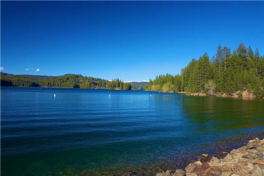This article has multiple issues. Please help improve it or discuss these issues on the talk page. (Learn how and when to remove these messages)
|
| Jenkinson Lake | |
|---|---|
 A view of the lake from the shore A view of the lake from the shore | |
  | |
| Location | Sly Park, California |
| Coordinates | 38°43′14.16″N 120°33′13.68″W / 38.7206000°N 120.5538000°W / 38.7206000; -120.5538000 |
| Type | Reservoir |
| Primary inflows | Camp Creek |
| Primary outflows | Sly Park Creek |
| Catchment area | 47 sq mi (120 km) |
| Basin countries | United States |
| First flooded | 1955 (1955) |
| Max. length | 2.5 mi (4.0 km) |
| Max. width | 2.21 mi (3.56 km) |
| Surface area | 650 acres (260 ha) |
| Water volume | 41,000 acre⋅ft (51 hm) |
| Shore length | ca. 8 mi (13 km) |
| Surface elevation | 3,400 ft (1,000 m) |
| Islands | 4 |
| Settlements | Sly Park, Pollock Pines |
| References | |
| Shore length is not a well-defined measure. | |
Jenkinson Lake is a reservoir located in El Dorado County, California near Pollock Pines, California named after Walter E. Jenkinson, manager of the El Dorado irrigation district.
There are two main parts, the upper and lower lake. The lower lake is about eight times larger than the upper lake, which is to the northeast of its partner. The lower lake is more of a rounded body, while the upper is more narrow.
In the upper eastern area of the upper lake lies a large inlet, which can be traced to a waterfall.
The Sly Park Dam can be found to the southern part of the lake, and an auxiliary dam can be found to the southeast.
Lake activities
Common activities include boating, camping, fishing, horseback riding, and hiking / biking.
The California Office of Environmental Health Hazard Assessment (OEHHA) has developed an advisory for Jenkinson Lake because of mercury found in fish caught from this water body. The advisory provides safe eating advice for Rainbow Trout, sunfish species, and black bass species.
2021 Caldor Fire
In early August 2021 The Caldor Fire was sweeping through Grizzly Flat and heading right for Jenkinson Lake, the area's main water source.
Once the smoke had cleared, local authorities concluded that the fire's intense heat and proximity to the lake had impacted the water quality of Lake Jenkinson.
The pine trees and bushes that once surrounded portions of the lake were destroyed in the fire, scorching the soil and releasing carbon. Carbon continues to be released as trees decay and the once-fertile soil turns pale and dusty. The forested area had been naturally storing carbon up for decades and the release of carbon from the wildfire was investigated for months following the blaze.
References
- "Hiking at Jenkinson Lake - Jenkinson Lake". Jenkinsonlake.com. Retrieved 2017-03-04.
- "Archived copy". Archived from the original on 2015-09-07. Retrieved 2016-05-09.
{{cite web}}: CS1 maint: archived copy as title (link) - "OEHHA". OEHHA. Retrieved 2018-02-14.
- Waldman, Heather (2022-06-18). "'Stark reminder of what can happen to your watershed': How high-intensity wildfires impact water quality years after the smoke clears". KCRA. Retrieved 2023-02-24.
External links
- "Jenkinson Lake | Fun in the Sun at Jenkinson Lake". www.jenkinsonlake.com. Retrieved 2017-03-04.
This El Dorado County, California–related article is a stub. You can help Misplaced Pages by expanding it. |